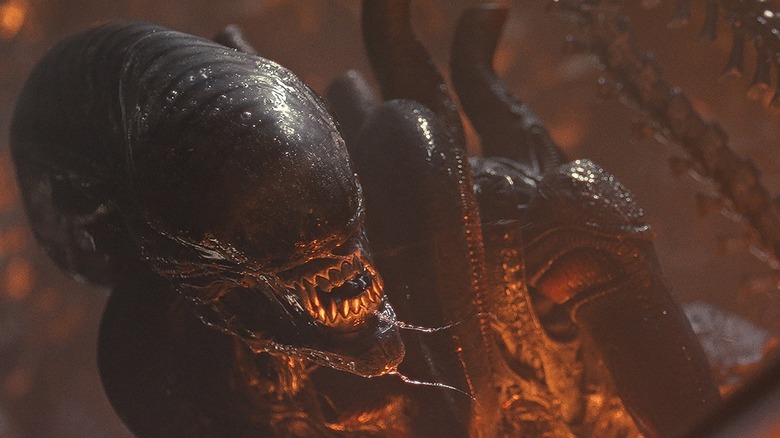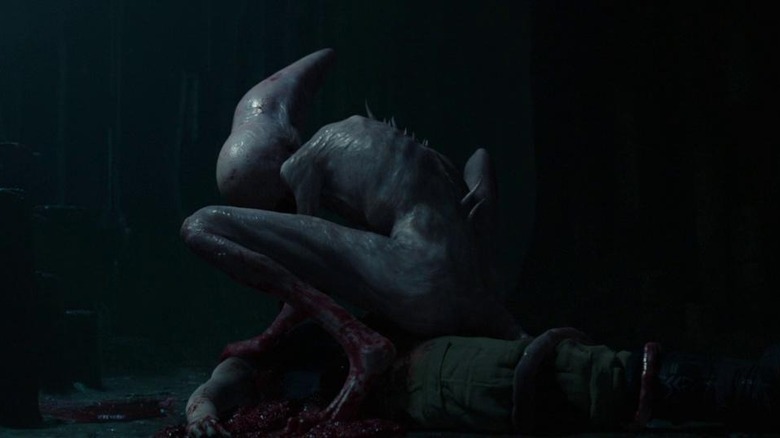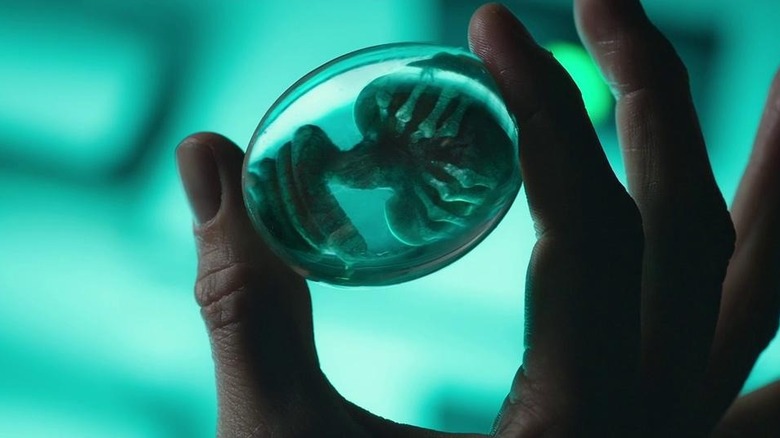This post contains massive spoilers for “Alien: Romulus.”
After seven years away from the silver screen, the “Alien” franchise has returned with a brand new installment. Director Fede Alvarez has moved away from Ridley Scott’s prequels and returned to a more back-to-basics approach to the series with “Alien: Romulus,” which takes place between the first two installments in the series. Centered on a new cast of characters, the film plays largely like a greatest-hits collection of sorts for most of its runtime. That is until the third act when Alvarez drops a very weird, very gross twist on the audience. While there is much to be said about that twist, one thing is inarguable; the “Alien” canon backs up the twist. More specifically, by Scott’s prequels.
The ending of “Alien: Romulus” introduces us to a horrifying hybrid creature known as the Offspring. The creature is part human, part Xenomorph, and part Engineer. For those who may not recall, the Engineers were introduced in “Prometheus” and were revealed to be responsible for creating humanity in the first place. This unholy creation came to be when Kay (Isabela Merced), who was pregnant, injected herself with a compound called Z-01 that was developed by the android Rook. Instead of saving her life, it created a wildly unsettling abomination that Rook saw as some sort of fast-forward in evolution for humanity.
I’m not here to debate the merits of the movie’s third act, or to open a discussion about how effective or ineffective the Offspring is as a narrative device. What I am here to do is point out that Scott’s prequels, particularly “Alien: Covenant,” most certainly justify the existence of such a creature. “Romulus” not only doesn’t ignore those films, but it actively embraces them. The Offspring is what brings it all together.
Alien: Covenant presented endless possibilities for the Xenomorphs
In 1979’s “Alien,” the Xenomorph is a mysterious extraterrestrial killing machine whose origins are left unexplored. “Prometheus” became essential to the franchise by introducing us to the Engineers and a spore that creates deadly creatures when it bonds with a host. We never see a full-blown Xenomorph in that film, but we do see something close to it, dubbed the Deacon, in the film’s closing minutes. The android David (Michael Fassbender) becomes the main character in the follow-up, 2017’s “Covenant.” Moreover, he is revealed to be a mad scientist of sorts who commits horrible atrocities with the alien spore.
“Covenant” is an intensely divisive movie and its relative failure at the box office made it so that Scott couldn’t finish his planned prequel trilogy. Be that as it may, it’s essential to the canon of the franchise as it truly is the first time we see the Xenomorph in its final form. A facehugger bonds with a human to create the beast as we know it. But it’s a very specific bit of chemistry that leads us to that place. Rather crucially, David’s experimentation showed us a wide variety of ways that the spore could manifest life. The Neomorph, for example, resulted from the horrific back-bursting scene early on in the film.
Beyond that, David’s workshop was a true house of horrors, showcasing the decade’s worth of experimenting he had done on the Engineer’s world after unleashing the payload of spores upon its inhabitants. The creatures took many forms, largely depending on the host the spore bonded with. The key thing with the Xenomorph is that it is a perfect organism born out of a very specific set of circumstances needing a human as a host. It’s far from the only way the spore can manifest deadly life.
Alien: Romulus continues the long, strange evolution of the Xenomorph
That brings us back to “Romulus.” Rook extracted the Z-01 compound from the Xenomorph itself. He essentially reverse-engineered the creature and distilled the original Engineer spore. As we know, that spore is very malleable. Hence, when Kay injected herself with the compound, with a child growing inside of her, it was hard to say what would happen. It resulted in a truly grotesque monstrosity the likes of which we’ve never seen, one that goes back to what Scott laid out in “Prometheus” and even more so in “Covenant.”
It’s also worth pointing out that this sort of bizarre experimentation goes beyond the prequels. “Alien: Resurrection,” for as messy of a movie as it is, gave us a human/Xenomorph hybrid dubbed the Newborn. Alvarez is merely continuing a long, strange tradition of evolving the creature beyond what audiences first met in 1979.
There is much to be said about “Romulus,” from the return of Ian Holm’s Rook thanks to potentially questionable CGI to the pretty impressive practical creature effects used elsewhere in the film. It’s a film we’re probably going to be having debates about for a long, long time. That’s all good and well. But it can’t be said that Alvarez was unjustified in creating the film’s hellish hybrid creature. Love it or hate it, that creation was fully supported by the canon. It fits in this universe.
“Alien: Romulus” is in theaters now.





